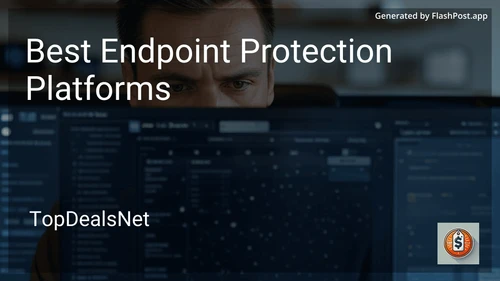Best Endpoint Protection Platforms in December 2025
In today's technologically advanced world, securing digital assets is more crucial than ever. With cyber threats becoming increasingly sophisticated, organizations must equip themselves with reliable endpoint protection platforms. This article explores the essentials of endpoint protection platforms and provides guidance on selecting the best one for your needs.
Understanding Endpoint Protection Platforms
Endpoint protection platforms (EPP) are comprehensive security solutions designed to defend endpoints-devices such as laptops, desktops, servers, and mobile devices-from cybersecurity threats. These platforms integrate a variety of security measures, including antivirus, anti-malware, firewall, and intrusion detection features, to offer robust protection against known and emerging threats.
Key Features of Endpoint Protection Platforms
When assessing endpoint protection platforms, it is important to consider several key features:
-
Comprehensive Threat Detection: A good EPP should provide real-time monitoring and detection of threats. It should leverage a combination of signature-based detection and behavioral analysis to identify known and unknown threats.
-
Centralized Management: Effective EPP solutions offer centralized management consoles, allowing IT administrators to monitor and control security policies across all endpoints within the network efficiently.
-
Scalability: As businesses grow, so does the number of endpoints. A scalable solution can accommodate this growth without compromising on performance or security.
-
Cross-Platform Compatibility: With a multitude of devices and operating systems in the workplace, it's crucial for an EPP to support various platforms to ensure uniform protection.
Evaluating Endpoint Protection Platforms
Choosing the best endpoint protection platform involves a strategic evaluation of your organization's specific needs and the available options. Here's a step-by-step guide on how to make the right choice:
1. Assess Your Security Requirements
Identify the level of protection your organization requires based on your industry, size, and risk profile. Consider conducting a risk assessment to pinpoint your unique vulnerabilities and security needs.
2. Consider Ease of Use
A user-friendly interface and straightforward deployment are crucial, especially if your IT team lacks cybersecurity expertise. Look for platforms that offer intuitive dashboards and easy-to-follow configurations.
3. Evaluate Integration Capabilities
Ensure that the EPP can seamlessly integrate with your existing cybersecurity infrastructure and other IT management tools. This integration facilitates better data sharing and enhances overall security posture.
4. Review Vendor Support and Reputation
Investigate the reputation of the EPP vendors. Look for customer reviews, market standing, and the quality of their customer support. A responsive vendor can greatly influence the efficiency of incident resolution.
Additional Resources
While securing your endpoints is vital, equipping yourself with the right tools and community support can further enhance your cybersecurity strategy. Explore these resources for additional insights:
- Best laptops for coding - Find high-performance laptops suited for developers and IT professionals to ensure seamless work experiences.
- Best coding communities - Connect with developer communities that share knowledge, solve problems, and stay updated on industry trends.
Conclusion
Endpoint protection platforms play a critical role in safeguarding an organization's digital assets. By understanding key features and evaluation criteria, businesses can make informed decisions and adopt EPP solutions that effectively mitigate cybersecurity risks. Remember, staying informed and proactive about security ensures resilience in an ever-evolving threat landscape.




